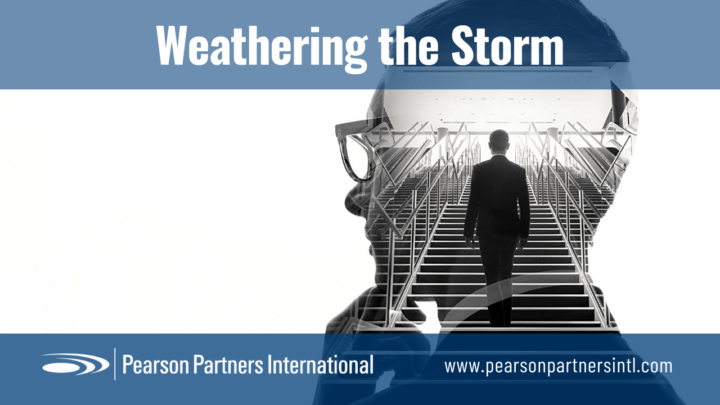Building Business Resilience with Ingenuity and Innovation
Pearson Partners International recently completed a study on the business and economic impact of COVID-19. Over 500 business leaders responded from across the United States, representing companies ranging from small, private organizations to multi-national conglomerates. They were asked how prepared their businesses were for a crisis, whether they had a formal business continuity plan in place prior to the pandemic, how they had responded and what steps they were taking to prepare for the future.
One subject stood out, and that was whether business leaders had a formal business continuity plan in place before the pandemic, and to what degree that helped their organizations weather the storm. This is the third in our series of articles analyzing the data from our study.
While the COVID-19 crisis caught many companies by surprise, more than half (58 percent) of respondents reported that their companies had a formal business continuity plan prior to the pandemic and felt that it was effective in helping them weather the storm. One respondent said, “Our technology worked as expected,” while another reported, “Our team’s adaptability of technology was unknown and untested in a WFH environment of this magnitude. We closed our eyes and jumped and landed fairly comfortably.” A third commented, “Our technology and security were well planned, and communication was increased during the crisis.”
More than two-thirds (68 percent) of respondents said they thought their business continuity plans were solid but did not necessarily include contingencies for the drastic nature of a pandemic. Many reported that they modified their plans as the crisis developed. One CEO said, “We had a crisis team already identified and we were highly organized. Communications throughout the organization went well. We had to continue to evolve as the pandemic evolved, and we kept U.S. office locations closed longer than originally expected.” Another said, “We planned for a scenario much like this pandemic. However, it lacked some community aspects, which we addressed quickly and learned a lot from.”
Reliable company network access was a mainstay of the work-from-home plan for many organizations. One IT leader said their company’s plan was thorough and effective: “We did a corporate-wide test as things started to progress in early March so we would know whether the network could handle 500+ people on the VPN each day. We had team calls every other day during the crisis and were tracking issues internally and with third-party vendors. We had practiced the plan several times in the 12 to 18 months [prior to the pandemic].”
While the economic impact of the crisis on most businesses has been undeniable, two-thirds (66 percent) of respondents believed that their companies were financially stable. Many felt their companies had prepared well for an economic downturn. One commented that their company was weathering the COVID-19 crisis well because it had “built sufficient pre-crisis liquidity and maintained adequate financial borrowing capacity.” Another said, “Our management team is first-rate and has spent a lot of time over the years ensuring financial stability that would continue through a crisis.” A third commented, “Our company is backed by a large parent company with cash reserves and lines of credit. We have done a lot of work to reduce our cash outflow and protect our cash positions, and we have been working with the government on subsidies.”
Many respondents reported that their companies had taken the opportunity to grow and diversify their holdings and market share. “Our company has significant levels of liquidity,” said one respondent, “and we can make opportunistic acquisitions to take advantage of distressed situations.” Another reported, “We are focusing on top priorities, collaborating as much as possible with strong communication channels and looking at our practices for diversification to meet new market demands.” Others reported that the government’s Payroll Protection Program loans had helped them stay in business and retain employees during the crisis. “The PPP helped stabilize our cash flow, but we should be in OK shape until we see more activity,” said one CEO.
The COVID-19 crisis has forced many companies to adapt and find new ways of doing business to weather the storm. Many respondents reported innovative and thoughtful approaches, including increasing frequency of communication and providing more opportunities for collaboration. One respondent said, “We maintained continuity by providing employees opportunities to connect with business leaders in other industries facing similar challenges.” Another said, “We experienced an increase in demand for services and we adapted as we went along.” One respondent reported that “having conversations with clients and providing guidance to them on how to deal with COVID-19 was significant. We have stayed close to our clients and have helped them stabilize their organizations and mitigate their financial risk.” Another said, “Our firm adapted extremely well. Everyone quickly received the tools necessary to work from home and adapted to the technology.” One healthcare CEO said, “Communication was key, so we implemented daily stand-up meetings, check-in calls and updates. These all remain in place months into the response.” One CFO of a professional services firm said, “Our firm adapted extremely well. Everyone quickly received the tools necessary to work from home and adapted to the technology.”
The crisis has provided significant lessons about business disruption, and many respondents commented on how their organizations had adjusted their business continuity plans for future contingencies. One respondent said, “We will survey that which worked well during this pandemic, improve the processes as needed and evaluate each step of our protocol to determine what worked and what did not.” One technology executive said, “We increased integration of technology into operations support and strengthened remote work functions in case of future disaster or business interruption events.” One sales organization leader reported, “We have identified areas for cost savings through reduction of inefficiencies.” Another respondent said they would “have technology in place to address the need to work remotely.” One CMO in the construction industry said, “We will document some of the new processes developed during the crisis. We will have a customer list ready to go for messaging and CRM, and we will have a more fully developed sales database and better internal communications and training. Next time, we would be able to quickly move to a predetermined plan rather than making it up as we go.” Another respondent reported plans for a shift to a fully remote workforce, saying, “We realized that office space is not needed. We will close commercial office space knowing that employees can work effectively from home.”
Many respondents commented on the health risks of the pandemic and how they were adjusting their business continuity plans accordingly. Several noted a new definition of workplace safety in the wake of the pandemic, with one respondent reporting that “protecting our employees while at work will be our greatest challenge going forward. We will need to provide PPE [personal protective equipment] and will probably continue to work in shifts to provide for social distancing and avoid having a sickness shut us down.” “We have many facilities,” said another respondent, “and we will control access more carefully. We now have a work-from-home infrastructure in place, and we will likely improve that.” One respondent said, “We planned for the possibility of moving production to other facilities in case of having to shut down a plant and put protective measures in place to mitigate contamination of the work environment.” Another commented, “We will think through pandemic staff impacts—mainly the aspects of contact tracing and self-quarantines on key functions as potential disease cases popped up. We had an ‘essential functions’ team prior to the crisis, but it was pretty thin. We realized that if one or two of those people were to get symptoms or a positive test, it would ripple quickly through direct and second-degree contacts, who then would have had to take further quarantine actions, quickly cutting into the physical workforce.”
Several respondents offered salient suggestions for how businesses might recover and mitigate future risk. Said one energy industry leader, “There is no better time than now to change your life. For many, the slate is clean and the playing field more level. Do not let the world pass you by this time. Be smart and fast.”
___________________________________________
Learn more in our full white paper on The Business and Economic Impact of COVID-19.



















